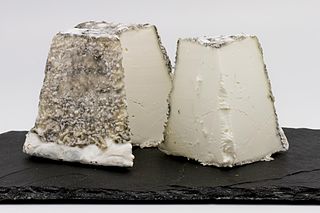 W
WThis is a list of goat milk cheeses. Goat cheese is produced using goat milk, the milk of domestic goats. The milk is commonly used to make cultured dairy products, such as cheese. Myriad goat milk cheeses are produced around the world.
 W
WAnari is a fresh mild whey cheese produced in Cyprus. Although much less known than other Cypriot cheeses, it gained popularity following publicity. One of the main industrial producers on the island won a silver medal award for anari in the 2005 World Cheese Awards in the UK. It has since become available in UK national supermarkets.
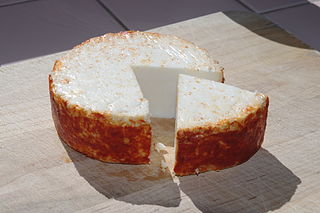 W
WAñejo cheese is a firm, aged Mexican cheese traditionally made from skimmed goat's milk, but most often available made from skimmed cow's milk. After it is made, it is rolled in paprika to add additional flavor to its salty, sharp flavor, which is somewhat similar to Parmesan cheese or Romano cheese, but not as strongly flavored as cotija cheese. As a fresh cheese, it is crumbly and breaks into small pieces very easily. When dried, it acquires a firm texture, allowing it to be easily shredded or grated. Queso añejo is a good baking or grilling cheese, which is generally sprinkled on top of or stuffed into enchiladas, burritos, and tacos. Parmesan, Cotija, or feta cheese can be substituted when añejo is not available. It may also be referred to as añejo enchilado cheese or añejo.
 W
WAnthotyros, is a traditional fresh cheese. There are Dry Anthotyros and Fresh Anthotyros. Dry Anthotyros is a matured cheese similar to Mizithra. Anthotyros is made with milk and whey from sheep or goats, sometimes in combination. The ratio of milk to whey usually is 9-to-1. It is commonly a truncated cone, but when shipped in containers may be crumbled, as it is removed. It may be unpasteurized, where law allows.
 W
WBanon is a French cheese made in the region around the town of Banon in Provence, south-east France.
 W
WBastardo del Grappa is a traditional cheese produced in the foothills of Monte Grappa massif and in the provinces of Treviso, Belluno, and Vicenza, in Italy. Bastardo del Grappa is a certified PAT cheese qualifying it as a genuine Italian product.
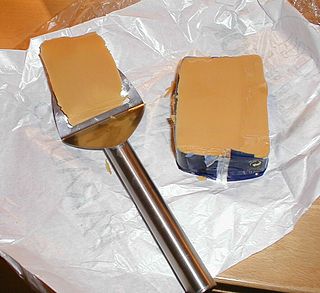 W
WBrunost is a common, Norwegian name for mysost, a family of cheese-related foods made with whey, milk, and/or cream. The term is often used to just refer to the Gudbrandsdalsost type, which is the most popular variety. Brunost is primarily produced and consumed in Norway. It is regarded as one of the country's most iconic foodstuffs, and is considered an important part of Norwegian gastronomical and cultural identity and heritage.
 W
WBûcheron is a goat's milk cheese native to the Loire Valley in France. Semi-aged, ripening for 5 to 10 weeks, Bucheron is produced as short logs that weigh 3 to 4 pounds that are sliced and sold as small rounds in food stores.
 W
WCabecou is a soft goat cheese that comes from the Midi-Pyrénées region of southern France. It has a thin striped rind and after 2 weeks its crust grows blue mold changing its taste. It is one of Aquitaine's most famous foods. Aquitaine is a region in the lower bottom of France. The coloration of this creation is a calm cream color.
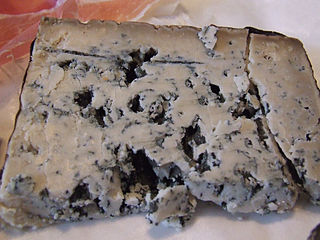 W
WCabrales is a blue cheese made in the artisan tradition by rural dairy farmers in Asturias, Spain. This cheese can be made from pure, unpasteurized cow’s milk or blended in the traditional manner with goat and/or sheep milk, which lends the cheese a stronger, spicier flavor.
 W
WCaciotta, from the Tuscan cacciola, is a range of types of cheese produced in Italy from the milk of cows, sheep, goats, or water buffalo.
 W
WCaprino is an Italian cheese traditionally made from whole or skim goat's milk. The name of the cheese derives from the Italian word for goat, capra. With modern methods of production, the cheese is made from cow's milk as well or a combination of both cow's and goat's milks. The two major styles of caprino are fresco (fresh) and stagionato (aged).
 W
WCastelo Branco is a cheese named after the city of the same name in Portugal, the main city of the district where it is produced.
 W
WCathare is a goat's milk cheese from the Languedoc-Roussillon region of France. The cheese comes in flat discs whose face is covered in charcoal powder with the Occitan cross inscribed. Under the rind, Cathare is pure white with a soft, creamy texture. Its goat-milk flavor intensifies as it ages, and reaches its prime after two to three weeks, which makes it typically unavailable in the United States, due to the Food and Drug Administration's stance that raw milk soft cheeses can pose a health risk. The sale of raw milk cheese aged under 60 days is illegal in the United States.
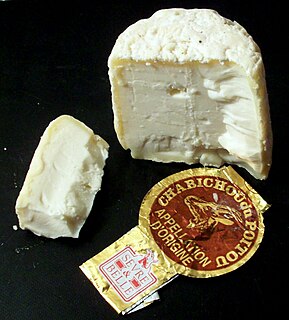 W
WChabichou is a traditional soft, unpasteurized, natural-rind French goat cheese with a firm and creamy texture. Chabichou is aged for 10 to 20 days.
 W
WChaubier is a washed rind French Cheese made from half goat's milk and half cow's milk. The cheese was produced by the Soignon division of DCI's cheese section. The cheese was discontinued in 2012 with small amounts of the cheese being available in 2013 from distributors.
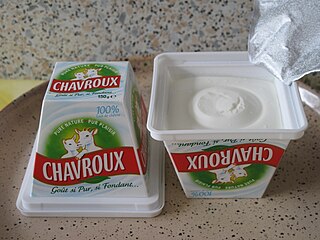 W
WChavroux is a French factory produced soft cheese made using goat's milk.
 W
WCircassian cheese (Adyghe: адыгэ къуае Adyghe pronunciation: [aːdəɣa qʷaːja], Russian: адыгейский сыр adygeyskiy syr, is a Circassian cheese found across the North Caucasus, the Levant and other areas with a Circassian diaspora.
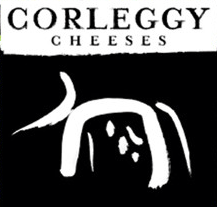 W
WCorleggy Cheeses is an Irish farmhouse making a selection of cheese in County Cavan. It was started by Silke Cropp in 1985 using milk from her own goat herd. Today Corleggy make a variety of different cheese from goat's milk, sheep's milk and cow's milk sourced from local farmers.
 W
WCouronne lochoise is a soft and creamy raw goat's milk cheese originating in the farmlands of the Loches area of Touraine in the Loire Valley, France. Its name literally translates to "Crown of Loches", which references its doughnut shape. Its texture and taste resembles that of buttered pastry.
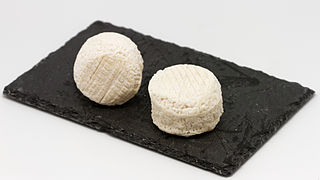 W
WCrottin de Chavignol is a goat cheese produced in the Loire Valley. This cheese is the claim to fame for the village of Chavignol, France, which has only two hundred inhabitants.
 W
WEgyptian cheese has a long history, and continues to be an important part of the Egyptian diet. There is evidence of cheese-making over 5,000 years ago in the time of the First Dynasty of Egypt. In the Middle Ages the city of Damietta was famous for its soft, white cheese. Cheese was also imported, and the common hard yellow cheese, rumi takes its name from the Arabic word for "Roman". Although many rural people still make their own cheese, notably the fermented mish, mass-produced cheeses are becoming more common. Cheese is often served with breakfast, and is included in several traditional dishes, and even in some desserts.
 W
WFaisselle is a non-protected French cheese made of raw milk from cows, goats, or sheep. The name comes from the mold in which the cheese is strained: faisselle.
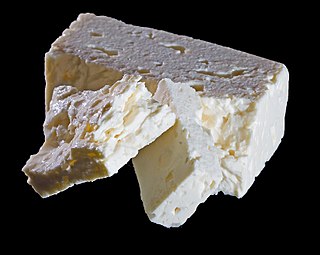 W
WFeta is a Greek brined curd white cheese made from sheep's milk or from a mixture of sheep and goat's milk. It is a soft, brined white cheese with small or no holes, a compact touch, few cuts, and no skin. It is formed into large blocks, and aged in brine. Its flavor is tangy and salty, ranging from mild to sharp. It is crumbly and has a slightly grainy texture. Feta is used as a table cheese, in salads such as Greek salad, and in pastries, notably the phyllo-based Greek dishes spanakopita and tyropita. It is often served with olive oil or olives, and sprinkled with aromatic herbs such as oregano. It can also be served cooked, as part of a sandwich, in omelettes, and many other dishes.
 W
WGarrotxa is a traditional Catalan goat's milk cheese. Almost extinct by the early 1980s, it has been revived by a young cheesemakers and goat farmers' cooperative in the Garrotxa area of Catalonia. The revival began in 1981, and the cheese has since become widespread in artisanal production.
 W
WDunlop is a mild cheese or 'sweet-milk cheese' from Dunlop, East Ayrshire, Scotland. It resembles a soft Cheddar cheese in texture. Though it fell out of popularity some time after the end of the Second World War, it is now appreciated for its value in various recipes and for eating on its own or with a dram of whisky.
 W
WGlyde Farm Produce was set up in 1996 by Peter Thomas who spent the next several years researching the market in Ireland for suitable dairy products. Peter and Anita Thomas started making Bellingham Blue cheese at their family farm at Mansfieldtown in County Louth, Ireland, in 2000.
 W
WThe domestic goat or simply goat is a subspecies of C. aegagrus domesticated from the wild goat of Southwest Asia and Eastern Europe. The goat is a member of the animal family Bovidae and the subfamily Caprinae, meaning it is closely related to the sheep. There are over 300 distinct breeds of goat. It is one of the oldest domesticated species of animal, according to archaeological evidence that its earliest domestication occurred in Iran at 10,000 calibrated calendar years ago.
 W
WGoat's cheese, or chèvre, is cheese made from goat's milk. Goat cheeses are made in a wide variety of styles, from soft fresh cheese to hard aged cheese.
 W
WGraviera is a cheese from Greece produced in various parts of Greece, the main of which are: Crete, Lesbos, Naxos and Amfilochia. It is not to be confused with the Swiss cheese gruyère, which is a related cheese that in some languages has a name similar to Graviera.
 W
WHalloumi or haloumi is a semi-hard, unripened, cheese made from a mixture of goat's and sheep's milk, and sometimes also cow's milk. It has a high melting point and so can easily be fried or grilled. This property makes it a popular meat substitute. Rennet is used to curdle the milk in halloumi production, although no acid-producing bacteria are used in its preparation.
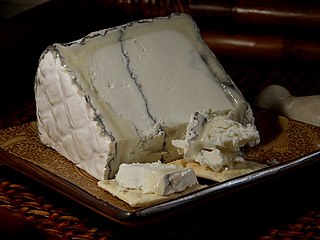 W
WHumboldt Fog is a goat milk cheese made by Cypress Grove, of Arcata, California, in Humboldt County. It is named for the local ocean fog which rolls in from Humboldt Bay.
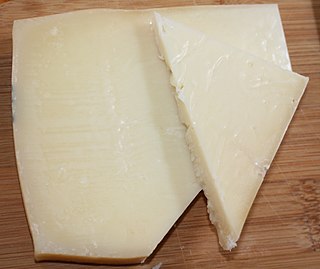 W
WKefalotyri or kefalotiri is a hard, salty white cheese made from sheep milk or goat's milk in Greece and Cyprus. A similar cheese Kefalograviera, also made from sheep or goat milk, is sometimes sold outside Greece and Cyprus as Kefalotyri. Depending on the mixture of milk used in the process the color can vary between yellow and white.
 W
WLeipäjuusto or juustoleipä, also known in the United States as Bread cheese or Finnish squeaky cheese, is a Finnish fresh cheese traditionally made from cow's beestings, rich milk from a cow that has recently calved. Reindeer or even goat milk can also be used. Commercially available versions are typically made from cow's milk, and they lack some of the colour and flavour because of this. The cheese originally comes from Southern Ostrobothnia, Northern Finland, and Kainuu.
 W
WTraditionally, many distinct types of cheeses have originated from Bosnia and Herzegovina, with as many varieties within each type.
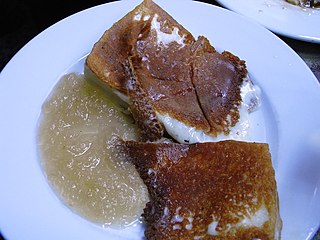 W
WMajorero is a goat milk cheese from Spain. Similar to Manchego, this firm cheese has a milky, nutty flavour that goes well with various pear products. It is pale white in colour, and comes in large wheels. Currently it is protected under European Law with Protected Designation of Origin (PDO) status.
 W
WManouri (μανούρι) is a Greek semi-soft, fresh white whey cheese made from goat or sheep milk as a by-product following the production of feta. It is produced primarily in Thessalia and Macedonia in central and northern Greece.
 W
WMató is a fresh cheese of Catalonia made from cows' or goats' milk, with no salt added.
 W
WMizithra or myzithra is a mixed milk-whey cheese from sheep or goats, or both. It is sold both as a fresh cheese, similar to Italian ricotta, and as a salt-dried grating cheese, similar to Italian ricotta salata. The ratio of milk to whey usually is 7 to 3.
 W
WNabulsi is one of a number of Palestinian white brined cheeses made in the Middle East. Its name refers to its place of origin, Nablus, and it is well known throughout the West Bank and surrounding regions. Nabulsi, along with Akkawi cheese, is one of the principal cheeses consumed in Jordan. It is produced primarily from sheep milk; alternatively, goat's milk may be used. Nabulsi cheese is white and rectangular in shape. It is semi-hard with no gas holes. It becomes soft and elastic when heated. It is a typical ewe's or goat's milk cheese, but is traditionally flavored with mahleb and mastic added to the boiling brine. It can be eaten fresh as salty table cheese or can be fried in oil, and it is also a major ingredient of the Palestinian dessert knafeh.
 W
WPayoyo cheese is a type of cheese made from the milk of Payoya goats and Merina grazalemeña sheep in Villaluenga del Rosario and other areas of the Sierra de Grazalema, Spain. It began production in 1997 and has become a staple of Spanish delicatessen. The term payoyo is the demonym for Villaluenga del Rosario.
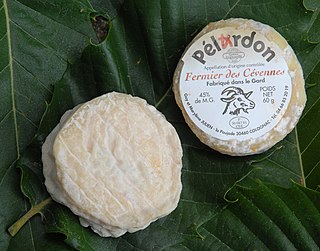 W
WPélardon, formerly called paraldon, pélardou and also péraudou, is a French cheese from the Cévennes range of the Languedoc-Roussillon region. It is a traditional cheese made from goat's milk. It is round soft-ripened cheese covered in a white mold weighing approximately 60 grams, with a diameter of 60-70 mm and a height of 22-27 mm. Pélardon has benefited from Appellation d'origine contrôlée (AOC) status since August 2000.
 W
WPicodon is a goats-milk cheese made in the region around the Rhône in southern France. The name means "spicy" in Occitan.
 W
WPicón Bejes-Tresviso is a blue cheese from Cantabria, in the north of Spain. It has been protected under Denominación de Origen (DO) legislation since 1994, prior to which it was traditionally known as Picón de Tresviso and Queso Picón de Bejes. The designated area centers in the Liébana valley and production is restricted to the municipalities of Potes, Pesaguero, Cabezón de Liébana, Camaleño, Cillorigo de Liébana, Peñarrubia, Tresviso and Vega de Liébana.
 W
WThe rigotte de Condrieu is a type of cheese made with goat's milk which originates in the Lyonnaise region of France and is named after the town of Condrieu.
 W
WRobiola is an Italian soft-ripened cheese of the Stracchino family. It is from the Langhe region and made with varying proportions of cow's, goat's and sheep milk. One theory is that the cheese gets its name from the town of Robbio in the province of Pavia; another that the name comes from the word rubeole (ruddy) because of the color of the seasoned rind.
 W
WRocamadour is a French cheese from the southwest part of the country. It is produced in the regions of Périgord and Quercy and takes its name from the village of Rocamadour in the département of the Lot.
 W
WRubing is a firm, acid-set, non-melting, fresh goat milk farmer cheese made in the Yunnan Province of China by people of the Bai and Sani minorities. Its Bai name is youdbap, meaning "goat's milk".
 W
WSainte-Maure de Touraine is a French cheese produced in the province of Touraine, mainly in the department of Indre-et-Loire. It is named after the small town of Sainte-Maure-de-Touraine, in the department of Indre-et-Loire, at equal distance from westly Chinon and eastly Loches.
 W
WSelles-sur-Cher is a French goat-milk cheese made in the Centre-Val de Loire region of France. Its name is derived from the commune of Selles-sur-Cher in the Loir-et-Cher department where it was first made in the 19th century.
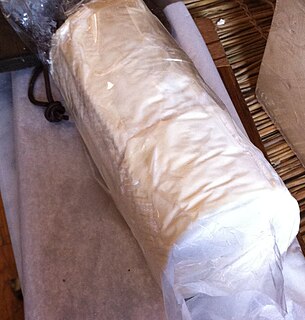 W
WSt Tola goats cheese is a range of handmade goat's milk cheese made in Inagh, County Clare. A range of cheese are produced varying from fresh soft cheese to a Gouda style hard cheese.
 W
WTulum cheese is a traditional Turkish goat's milk cheese ripened in a goatskin casing, called tulum in Turkish. Due to its unique flavor, it is preferred as meze to rakı in Turkey.
 W
WValençay is a cheese made in the province of Berry in central France. Its name is derived from the town of Valençay in the Indre department.
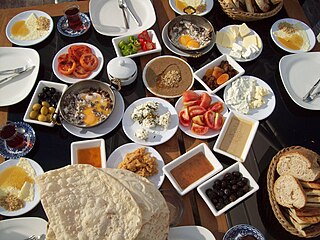 W
WVan herbed cheese is a type of cheese made out of sheep's or cow's milk. Ripened cheese varieties containing herbs are traditional in Turkey and have been manufactured for more than 200 years in the east and southeast of the country. They are manufactured from raw milk, semi-hard in texture and salty in taste and have the aroma of garlic or thyme due to added herbs. Twenty-five types of herb, including Allium, Thymus, Silene and Ferula species which are most popular, are used individually or as appropriate mixtures. The most popular of these cheeses is Otlu which is produced mainly in the Van Province of Turkey in small dairies and villages, but now is produced in other cities of the eastern region of Turkey and its popularity increases continuously throughout Turkey.